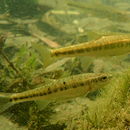Diagnostic Description
provided by Fishbase
Diagnosed from its congeners in Europe by having lateral line usually reaching beyond anal fin base, a midlateral row of vertically elongated blotches whose depth is about 1/3-1/2 of body depth at same position, often fused in a midlateral stripe (in preserved individuals), caudal peduncle depth 2.6-3.1 times in its length, patches of breast scales separated by unscaled area or (rarely) connected anteriorly by 1-2 rows of scales, snout length 29-34% HL ( 1.1-1.4 times eye diameter), and anal fin origin in front of base of last dorsal ray (Ref. 59043). Caudal fin with 19 rays (Ref. 2196).
Life Cycle
provided by Fishbase
Males and females form school separately and arrive on the spawning site at differen times. Spawn over clean gravel areas in flowing water or on wave-washed shores of lakes. Deposit eggs in shallow water on sand or gravel bottom which hatch in 4-5 days at 18°C. Females lay sticky eggs deep into clean gravel (Ref. 59043).
Migration
provided by Fishbase
Potamodromous. Migrating within streams, migratory in rivers, e.g. Saliminus, Moxostoma, Labeo. Migrations should be cyclical and predictable and cover more than 100 km.
- Recorder
- Crispina B. Binohlan
Morphology
provided by Fishbase
Dorsal spines (total): 3; Dorsal soft rays (total): 6 - 8; Analspines: 3; Analsoft rays: 6 - 8; Vertebrae: 38 - 40
Trophic Strategy
provided by Fishbase
Species has herbivorous-detritivorous tendencies (Ref. 12053).
Biology
provided by Fishbase
Gregarious (Ref. 2196). Found in a wide range of cold and well oxygenated habitats from small, fast-flowing streams to large Nordic lowland rivers and from small upland lakes to large oligotrophic lakes. Usually occurs in association with salmonid fishes (Ref. 59043). Feeds on algae, plant debris (in rivers), mollusks, crustaceans and insects (Ref. 30578). Spawns over clean gravel areas in flowing water or on wave-washed shores of lakes. Overwinters in coarse substrate or in deep pools with low current (Ref. 59043). Migrates upstream for spawning in shallow gravel areas. Important laboratory fish, for research on sensory organs of fishes. Mean maximum age is 6 years (Ref. 41616). Locally threatened due to pollution and excessive stocking of species of Salmo (Ref. 59043).
- Recorder
- Crispina B. Binohlan
Importance
provided by Fishbase
fisheries: minor commercial; aquarium: commercial; bait: usually
- Recorder
- Crispina B. Binohlan

